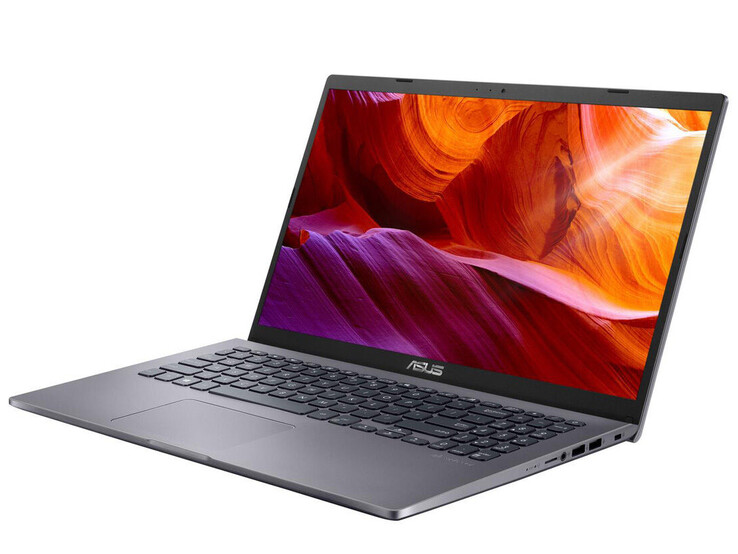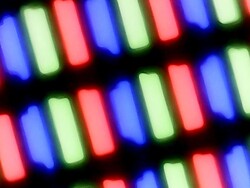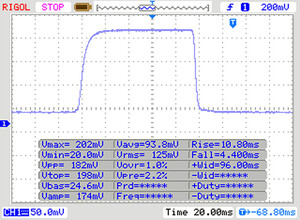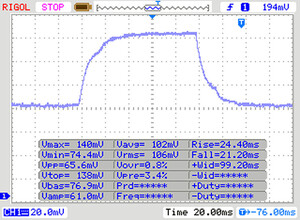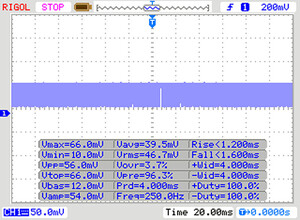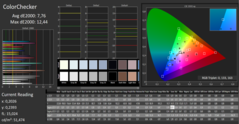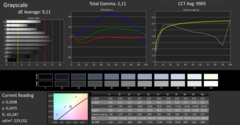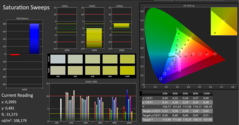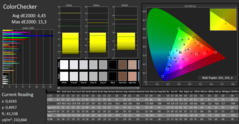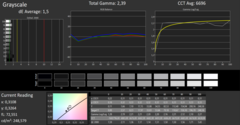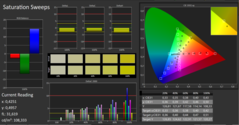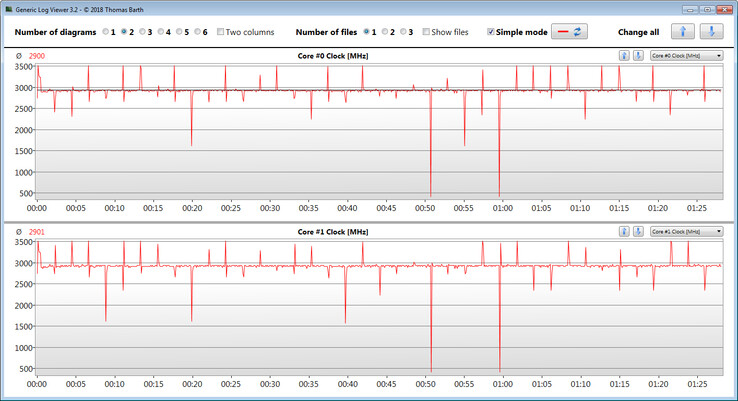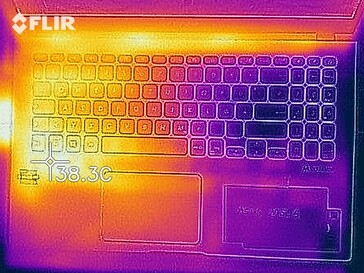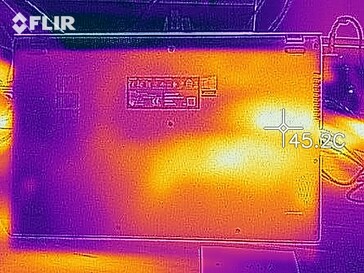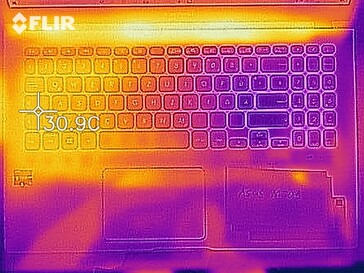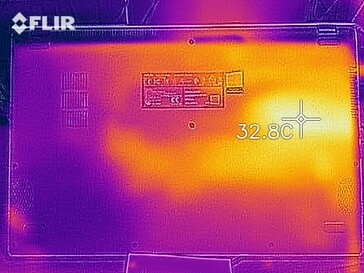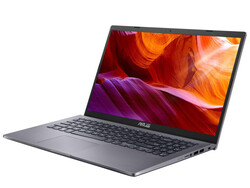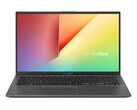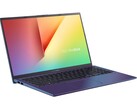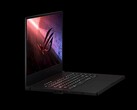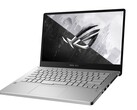Asus M509DA Review: Slow Speed WiFi in Ryzen 3 Notebook
Rating | Date | Model | Weight | Height | Size | Resolution | Price |
|---|---|---|---|---|---|---|---|
| 76.6 % v7 (old) | 01 / 2020 | Asus M509DA-EJ153T R3 3200U, Vega 3 | 1.8 kg | 22.9 mm | 15.60" | 1920x1080 | |
| 75.8 % v7 (old) | 01 / 2020 | Lenovo Ideapad S145-15API 81UT002XGE Athlon 300U, Vega 3 | 1.9 kg | 19.9 mm | 15.60" | 1366x768 | |
| 77.7 % v6 (old) | 03 / 2018 | HP 250 G6 2UB93ES 6006U, HD Graphics 520 | 2 kg | 25 mm | 15.60" | 1920x1080 | |
| 79 % v6 (old) | 06 / 2018 | Acer Aspire 3 A315-41-R7BM R3 2200U, Vega 3 | 2.4 kg | 29.2 mm | 15.60" | 1920x1080 |
Case, Equipment and Input Devices - Asus Relies on a Plastic Case For the M509DA
The upper side of the base unit and the back of the lid of the plastic case are kept in a light silver grey, the lower shell in a darker grey. The display frame is coloured black. Processing defects are not noticeable. On the stability side, there is still air on top: The base unit and especially the lid should have a greater stiffness. The battery is firmly installed. There is no maintenance flap. You can get to the insides by removing the base unit.
Asus gave the M509DA four USB slots (2x USB 2.0, 2x USB 3.2 Gen 1). The type C slot is only used for connecting peripherals. It neither supports display port-per-USB-C nor power delivery. An external display can be connected via HDMI. Instead of a memory card reader for full format SD cards, Asus has a MicroSD reader. The device belongs to the slow representatives of its kind.
The WLAN module carries a chip from Realtek (8821CE), which supports the WLAN standards 802.11 a/b/g/n/ac. The transmission speeds determined by us under optimal conditions (no other WLAN devices in the immediate vicinity, short distance between notebook and server PC) turn out badly.
The chiclet keyboard, which is suitable for everyday use, yields minimally while typing. This has not proven to be disturbing. The keyboard does not have any lighting. However, M509DA models with an illuminated keyboard are available according to the Asus website. A multi-touch capable clickpad (about 10.5 x 7.3 cm) serves as a mouse replacement.
| SD Card Reader | |
| average JPG Copy Test (av. of 3 runs) | |
| Acer Aspire 3 A315-41-R7BM (Toshiba Exceria Pro SDXC 64 GB UHS-II) | |
| Average of class Office (22.4 - 198.5, n=28, last 2 years) | |
| Asus M509DA-EJ153T (Toshiba Exceria Pro M501 microSDXC 64GB) | |
| HP 250 G6 2UB93ES (Toshiba Exceria Pro SDXC 64 GB UHS-II) | |
| Lenovo Ideapad S145-15API 81UT002XGE (Toshiba Exceria Pro SDXC 64 GB UHS-II) | |
| maximum AS SSD Seq Read Test (1GB) | |
| Acer Aspire 3 A315-41-R7BM (Toshiba Exceria Pro SDXC 64 GB UHS-II) | |
| Average of class Office (25 - 249, n=26, last 2 years) | |
| Asus M509DA-EJ153T (Toshiba Exceria Pro M501 microSDXC 64GB) | |
| Lenovo Ideapad S145-15API 81UT002XGE (Toshiba Exceria Pro SDXC 64 GB UHS-II) | |
| HP 250 G6 2UB93ES (Toshiba Exceria Pro SDXC 64 GB UHS-II) | |
| Networking | |
| iperf3 transmit AX12 | |
| HP 250 G6 2UB93ES | |
| Acer Aspire 3 A315-41-R7BM | |
| Lenovo Ideapad S145-15API 81UT002XGE | |
| Asus M509DA-EJ153T | |
| iperf3 receive AX12 | |
| Acer Aspire 3 A315-41-R7BM | |
| Lenovo Ideapad S145-15API 81UT002XGE | |
| HP 250 G6 2UB93ES | |
| Asus M509DA-EJ153T | |
Display - Asus Notebook with Dark, Low-contrast Panel
Brightness (212.3 cd/m²) and contrast (466:1) of the matt, unstable viewing angle of the 15.6-inch screen (1,920 x 1,080 pixels) are far too low. This makes the notebook primarily suitable for use inside buildings. We consider rates beyond 300 cd/m² or 1.000:1 as good. Unfortunately, the display shows a flickering with a frequency of 250 Hz at brightness levels of 20 percent and below.
The color display in the as-delivered state is not convincing. The target (Delta-E less than 3) is clearly missed with a Delta-E-2000 color deviation of just under 8. The display also suffers from a clear blue cast. By calibrating the screen, the color deviation drops to 4.45, the blue cast disappears and the gray scales are displayed in a much more balanced way. The screen cannot display the color spaces AdobeRGB (40 percent) and sRGB (63 percent).
| |||||||||||||||||||||||||
Brightness Distribution: 84 %
Center on Battery: 226 cd/m²
Contrast: 466:1 (Black: 0.485 cd/m²)
ΔE ColorChecker Calman: 7.76 | ∀{0.5-29.43 Ø4.77}
calibrated: 4.45
ΔE Greyscale Calman: 9.11 | ∀{0.09-98 Ø5}
63% sRGB (Argyll 1.6.3 3D)
40% AdobeRGB 1998 (Argyll 1.6.3 3D)
43% AdobeRGB 1998 (Argyll 3D)
62.4% sRGB (Argyll 3D)
41.58% Display P3 (Argyll 3D)
Gamma: 2.11
CCT: 9905 K
| Asus M509DA-EJ153T TN LED, 1920x1080, 15.6" | Lenovo Ideapad S145-15API 81UT002XGE TN LED, 1366x768, 15.6" | HP 250 G6 2UB93ES TN LED, 1920x1080, 15.6" | Acer Aspire 3 A315-41-R7BM TN LED, 1920x1080, 15.6" | |
|---|---|---|---|---|
| Display | -11% | -6% | -4% | |
| Display P3 Coverage (%) | 41.58 | 36.8 -11% | 39.11 -6% | 40.09 -4% |
| sRGB Coverage (%) | 62.4 | 55.4 -11% | 58.8 -6% | 59.7 -4% |
| AdobeRGB 1998 Coverage (%) | 43 | 38.02 -12% | 40.41 -6% | 41.47 -4% |
| Response Times | -9% | 7% | 1% | |
| Response Time Grey 50% / Grey 80% * (ms) | 45 ? | 43 ? 4% | 42 ? 7% | 44 ? 2% |
| Response Time Black / White * (ms) | 14 ? | 17 ? -21% | 13 ? 7% | 14 ? -0% |
| PWM Frequency (Hz) | 250 ? | 192 ? | 2500 ? | 25000 ? |
| Screen | -26% | -17% | -10% | |
| Brightness middle (cd/m²) | 226 | 218 -4% | 184 -19% | 234 4% |
| Brightness (cd/m²) | 212 | 207 -2% | 178 -16% | 211 0% |
| Brightness Distribution (%) | 84 | 80 -5% | 80 -5% | 83 -1% |
| Black Level * (cd/m²) | 0.485 | 0.645 -33% | 0.38 22% | 0.43 11% |
| Contrast (:1) | 466 | 338 -27% | 484 4% | 544 17% |
| Colorchecker dE 2000 * | 7.76 | 12.12 -56% | 11.29 -45% | 11.27 -45% |
| Colorchecker dE 2000 max. * | 12.44 | 23.06 -85% | 19.48 -57% | 18.03 -45% |
| Colorchecker dE 2000 calibrated * | 4.45 | 3.53 21% | ||
| Greyscale dE 2000 * | 9.11 | 15.09 -66% | 12.43 -36% | 11.54 -27% |
| Gamma | 2.11 104% | 2.32 95% | 2.34 94% | 2.09 105% |
| CCT | 9905 66% | 18082 36% | 13823 47% | 11607 56% |
| Color Space (Percent of AdobeRGB 1998) (%) | 40 | 35 -12% | 37 -7% | 38 -5% |
| Color Space (Percent of sRGB) (%) | 63 | 55 -13% | 59 -6% | 60 -5% |
| Total Average (Program / Settings) | -15% /
-21% | -5% /
-11% | -4% /
-7% |
* ... smaller is better
Display Response Times
| ↔ Response Time Black to White | ||
|---|---|---|
| 14 ms ... rise ↗ and fall ↘ combined | ↗ 10 ms rise | |
| ↘ 4 ms fall | ||
| The screen shows good response rates in our tests, but may be too slow for competitive gamers. In comparison, all tested devices range from 0.1 (minimum) to 240 (maximum) ms. » 33 % of all devices are better. This means that the measured response time is better than the average of all tested devices (20.2 ms). | ||
| ↔ Response Time 50% Grey to 80% Grey | ||
| 45 ms ... rise ↗ and fall ↘ combined | ↗ 24 ms rise | |
| ↘ 21 ms fall | ||
| The screen shows slow response rates in our tests and will be unsatisfactory for gamers. In comparison, all tested devices range from 0.165 (minimum) to 636 (maximum) ms. » 76 % of all devices are better. This means that the measured response time is worse than the average of all tested devices (31.6 ms). | ||
Screen Flickering / PWM (Pulse-Width Modulation)
| Screen flickering / PWM detected | 250 Hz | ≤ 20 % brightness setting | |
The display backlight flickers at 250 Hz (worst case, e.g., utilizing PWM) Flickering detected at a brightness setting of 20 % and below. There should be no flickering or PWM above this brightness setting. The frequency of 250 Hz is relatively low, so sensitive users will likely notice flickering and experience eyestrain at the stated brightness setting and below. In comparison: 53 % of all tested devices do not use PWM to dim the display. If PWM was detected, an average of 8084 (minimum: 5 - maximum: 343500) Hz was measured. | |||
Performance, Emissions and Battery Life - Ryzen 3 with Good Performance Development in the Asus Notebook
The computer offers enough power for office and internet applications. This is confirmed not least by the good results in the PC-Mark benchmark. The M509DA does not represent a gaming notebook. Nevertheless, games that only place moderate demands on the hardware achieve smooth refresh rates - with low resolutions and low quality settings.
The M509DA is powered by a Ryzen 3 3200U APU (2 CPU cores, 4 threads; Radeon RX Vega 3 GPU) from AMD. The Cinebench R15 loop test betrays that nothing stands in the way of a permanent, even power delivery. The CPU turbo is used with constant speed, but doesn't work at full power. The integrated Vega-3 GPU also does well and delivers the best results we've ever measured with this graphics core in some GPU benchmarks.
The computer produces a normal level of noise over the entire load range. In idle and under low load, the fan is often at a standstill. Although the Asus computer's hardware can work at full power for a long time, the notebook heats up moderately at best even under load. The stereo loudspeakers produce an acceptable sound that lacks bass.
The M509DA doesn't reveal an excessive hunger for energy. We register a maximum power consumption of 32 watts. The Asus computer doesn't belong to the long-runners. It reached a runtime of 5:34 h in our practical WLAN test (simulates the load when calling up websites with a script) - the small-capacity battery (32 Wh) makes itself felt here.
Cinebench R15 Loop
| Asus M509DA-EJ153T Intel SSD 660p SSDPEKNW512G8 | Lenovo Ideapad S145-15API 81UT002XGE Samsung PM991 MZALQ128HBHQ-000L2 | HP 250 G6 2UB93ES Samsung SSD PM871a MZNLN256HMHQ | Acer Aspire 3 A315-41-R7BM SK Hynix HFS256G39TND-N210A | Average Intel SSD 660p SSDPEKNW512G8 | Average of class Office | |
|---|---|---|---|---|---|---|
| CrystalDiskMark 5.2 / 6 | 8% | -46% | -55% | 14% | 139% | |
| Write 4K (MB/s) | 128.7 | 128.2 0% | 81 -37% | 64.5 -50% | 136 ? 6% | 154.7 ? 20% |
| Read 4K (MB/s) | 52.3 | 48.2 -8% | 31.48 -40% | 25.1 -52% | 55.2 ? 6% | 72.3 ? 38% |
| Write Seq (MB/s) | 984 | 953 -3% | 452.1 -54% | 260.2 -74% | 926 ? -6% | 2607 ? 165% |
| Read Seq (MB/s) | 1291 | 1547 20% | 486.5 -62% | 505 -61% | 1523 ? 18% | 3219 ? 149% |
| Write 4K Q32T1 (MB/s) | 235.7 | 238.9 1% | 184.6 -22% | 164 -30% | 381 ? 62% | 423 ? 79% |
| Read 4K Q32T1 (MB/s) | 324.6 | 319.8 -1% | 203.9 -37% | 200.7 -38% | 334 ? 3% | 517 ? 59% |
| Write Seq Q32T1 (MB/s) | 984 | 972 -1% | 483.2 -51% | 258.5 -74% | 987 ? 0% | 3877 ? 294% |
| Read Seq Q32T1 (MB/s) | 1390 | 2190 58% | 537 -61% | 513 -63% | 1744 ? 25% | 5671 ? 308% |
| BioShock Infinite - 1366x768 High Preset | |
| Asus M509DA-EJ153T | |
| Acer Aspire 3 A315-41-R7BM | |
| Average AMD Radeon RX Vega 3 (18 - 41.7, n=6) | |
| Lenovo Ideapad S145-15API 81UT002XGE | |
| HP 250 G6 2UB93ES | |
| low | med. | high | ultra | |
|---|---|---|---|---|
| BioShock Infinite (2013) | 84.2 | 48.1 | 41.7 | 13.6 |
Noise Emissions
Noise level
| Idle |
| 30.3 / 30.3 / 31.1 dB(A) |
| Load |
| 40.7 / 40.8 dB(A) |
 | ||
30 dB silent 40 dB(A) audible 50 dB(A) loud |
||
min: | ||
Temperature
(+) The maximum temperature on the upper side is 33.7 °C / 93 F, compared to the average of 34.3 °C / 94 F, ranging from 21.2 to 62.5 °C for the class Office.
(+) The bottom heats up to a maximum of 36.1 °C / 97 F, compared to the average of 36.8 °C / 98 F
(+) In idle usage, the average temperature for the upper side is 23.4 °C / 74 F, compared to the device average of 29.5 °C / 85 F.
(+) The palmrests and touchpad are cooler than skin temperature with a maximum of 27.3 °C / 81.1 F and are therefore cool to the touch.
(±) The average temperature of the palmrest area of similar devices was 27.6 °C / 81.7 F (+0.3 °C / 0.6 F).
Speakers
Asus M509DA-EJ153T audio analysis
(-) | not very loud speakers (60.1 dB)
Bass 100 - 315 Hz
(-) | nearly no bass - on average 17.2% lower than median
(±) | linearity of bass is average (9.4% delta to prev. frequency)
Mids 400 - 2000 Hz
(+) | balanced mids - only 2.7% away from median
(±) | linearity of mids is average (8.4% delta to prev. frequency)
Highs 2 - 16 kHz
(+) | balanced highs - only 1.9% away from median
(±) | linearity of highs is average (7.3% delta to prev. frequency)
Overall 100 - 16.000 Hz
(±) | linearity of overall sound is average (21.6% difference to median)
Compared to same class
» 53% of all tested devices in this class were better, 9% similar, 38% worse
» The best had a delta of 7%, average was 21%, worst was 53%
Compared to all devices tested
» 60% of all tested devices were better, 7% similar, 33% worse
» The best had a delta of 4%, average was 24%, worst was 134%
Energy Consumption
| Off / Standby | |
| Idle | |
| Load |
|
Key:
min: | |
Battery Life
Pros
Cons
Verdict
The built-in Ryzen-3-3200U-APU pleases with a good power delivery and offers enough computing power for office and internet applications. Thanks to the dual-channel memory, it is used to its full potential. The notebook barely heats up over the entire load range and works quietly at least in idle and at low load.
Asus supplies an office notebook for home use with the M509DA, which isn't free of weaknesses. Most users should be able to live with these.
An NVMe-SSD (512 GB) ensures a fast running system. An exchange of the SSD would be possible. To do so, the case would have to be opened. Inside the notebook there is a compartment for a 2.5 inch storage medium. However, neither the frame, which is necessary for the installation, nor the SATA port are included with our test device.
The matt Full HD display won't win any prizes. You're dealing with a dark, low-contrast and unstable viewing angle model. The keyboard made a decent impression and proved to be suitable for everyday use. The battery life doesn't tear anyone away. In our WLAN test, the M509DA achieves a battery life of only 5:34 h, because Asus decided on a small-capacity battery (32 Wh). We expect more from a 15.6 inch device nowadays.
Asus has not only put the red pencil to the battery. The webcam (VGA with poor image quality) and the Ethernet slot (not available) have also been spared. The lack of a full format SD card reader is also to be criticized. There is no lack of space for such a reader. Nevertheless, Asus has installed a MicroSD model.
Asus M509DA-EJ153T
- 01/21/2020 v7 (old)
Sascha Mölck





